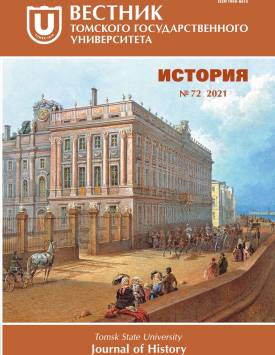The role of higher historical educationin the formation of social and cultural environment of the Lower Volga region in 1930-1980
The evolution of higher historical education in the Lower Volga region in the Soviet period is considered in the article, which continues the series of the authors’ publications on the history of the higher historical education and science in the Soviet period. On the basis of various historical sources, the analysis of the role of faculties and departments, historians of higher educational institutions in the Lower Volga region in the formation of social and cultural environment of the region is given in the article. The Saratov University, the Stalingrad and the Astrakhan Pedagogical Institutes were of particular importance in this process. Their importance in the formation of teaching staff in the region, the organization of museums and archives, scientific and educational work, the study of regional history is also noted. In particular, archaeological research on the territory of the Lower Volga region conducted by scientists from regional universities made a significant contribution to the study of local lore. This activity began with the arrival in Saratov of a well-known Egyptologist FV Ballod, who began excavating the ruins of the Golden Horde cities on the banks of the Volga. New archival sources are introduced into scientific discourse - universities reports, historians’ letters, party and government documents, etc. The article provides a comprehensive analysis of macro and micro factors which determined the structure of the regional system of higher historical education, its subsequent reorganization, peculiarities of its formation, activity and relationship of the teaching staff, social structure and specific features of forming the students body, etc. Particular attention is paid to the formation of the teaching staff of historical departments, scientific schools, which in many ways determined the unique image of the regional system of professional training of historians. The stages of development of higher historical education in the Lower Volga region are identified and described in the article. The work of all universities in the Lower Volga region, which conducted professional training of historians in the specified period, is presented. It is emphasized that both general direction of the Soviet higher historical education determined by the Party and government bodies, and the specific features of the development of the Lower Volga region in that period influenced its development. It is concluded that the gap between university and academic science, which was formed in the pre-war period, had a negative impact on the formation of qualified teaching staff. However, the reform of postgraduate training of historians in higher educational institutions, the expansion of the system of postgraduate studies in history and distribution of specialists across the country, contributed much to substantial progress in solving this complex problem in higher educational institutions in the Lower Volga region.
Keywords
scientific school, Kalmyk Pedagogical Institute, Volgograd Pedagogical Institute, Astrakhan Pedagogical Institute, Saratov State University, higher historical educationAuthors
| Name | Organization | |
| Khoroshenkova Anna V. | Volgograd State Socio-Pedagogical University | horav73@mail.ru |
References

The role of higher historical educationin the formation of social and cultural environment of the Lower Volga region in 1930-1980 | Tomsk State University Journal of History. 2021. № 72. DOI: 10.17223/19988613/72/12
